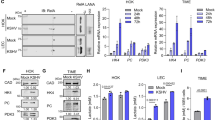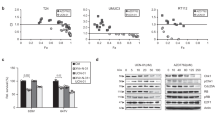Abstract
Nucleoside analogs (NAs) have been used extensively in both antitumor and antiviral therapies. Their general mechanism of action has been postulated to result from incorporation into DNA, leading to disruption of DNA synthesis and DNA polymerase inhibition. To further explore the antitumor mechanisms of NAs we have evaluated ganciclovir (GCV), an NA antiviral agent, in herpes simplex virus thymidine kinase (HSV-TK) gene–modified tumor cells. This system allows specific evaluation of the antitumor effects of NAs because the antitumor effect is directly related to the phosphorylation of the prodrug GCV by the HSV-TK enzyme in the gene-modified tumor cells. We demonstrated that GCV incorporates into DNA and inhibits DNA polymerase, as has been observed in HSV–infected cells and with other antitumor NAs in tumor cells. A novel observation is that GCV activates MAP kinase within 1 hour of GCV exposure. This activation directly correlates with cytotoxicity, because inhibition of the MAP kinase extracellular regulated kinase (Erk) by PD98059, reversed GCV-mediated cytotoxicity. This effect appears to be specific to the Erk pathway, because inhibition of the p38 kinase with SB203580 had no effect on cytotoxicity. Further, GCV does not act as a DNA-damaging agent or activate general DNA-repair mechanisms, but does produce a number of metabolic disruptions, including a reversible decrease in NAD levels. These effects appear to be downstream of the earlier activation of Erk in this system, which may be a novel mechanism of action for GCV cytotoxicity in HSV-TK gene–modified tumor cells, and thus, needs to be further evaluated as the mechanism of tumor cell killing by other antitumor NAs.
This is a preview of subscription content, access via your institution
Access options
Subscribe to this journal
Receive 12 print issues and online access
$259.00 per year
only $21.58 per issue
Buy this article
- Purchase on Springer Link
- Instant access to full article PDF
Prices may be subject to local taxes which are calculated during checkout








Similar content being viewed by others

References
Hejna M, Kornek GV, Raderer M, Ulrich-Pur H et al. Treatment of patients with advanced nonsmall cell lung carcinoma using docetaxel and gemcitabine plus G-CSF Cancer 2000 89: 516–522
Gandhi V, Estey E, Keating MJ, Chucrallah A, Plunkett W . Chlorodeoxyadenosine and arabinosylcytosine in patients with AML: pharmacokinetic, pharmacodynamic, and molecular interactions Blood 1996 87: 256–264
Elion G . The chemotherapeutic exploitation of virus specific enzymes Enzyme Regul 1980 18: 53–66
Reardon J . Herpes simplex virus type I and human DNA polymerase interactions with 2′deoxyguanosine5′ triphosphate analogues. Kinetics of incorporation into DNA and induction of inhibition J Biol Chem 1989 264: 19039–19044
St. Clair MH, Lambe CU, Furman PA . Inhibition by ganciclovir of cell growth and DNA synthesis of cells biochemically transformed with herpesvirus genetic information Antimicrob Agents Chemother 1987 31: 844–847
Coen DM,, Fleming HE, Leslie LK, Rotondo MJ . Sensitivity of arabinosyladenine resistant mutants of herpes simplex virus to other antiviral drugs and mapping of drug hypersensitivity mutations to the DNA polymerase locus J Virol 1985 53: 477–488
Chun YS, Park N . Effect of ganciclovir on viral DNA and protein synthesis in cells infected with herpes simplex virus Antimicrob Agents Chemother 1987 31: 349–351
Culver KW, Ram Z, Wallbridge S, Ishii H, Oldfield E, Blaese RM . In vivo gene transfer with retroviral vector producer cells for treatment of experimental brain tumors Science 1992 256: 1550–1552
Freeman SM, Abboud CN, Whartenby KA, Abraham GN . The bystander effect: tumor regression when a fraction of the mass contains the HSV-TK gene Cancer Res 1993 53: 5274–5283
Whartenby KA, Darnowski JW, Freeman SM, Yurasha K, Calabresi P . Recombinant interferon alpha 2a synergistically enhances ganciclovir mediated tumor cell killing in the herpes simplex virus thymidine kinase system Cancer Gene Ther 1999 6: 402–408
Chang L, Karin M . Mammalian MAP kinase signalling cascades Nature 2001 410: 37–40
Johnson NL, Gardner AM, Diener KM et al. Signal transduction pathways regulated by mitogen activated extracellular response kinase kinase kinase induce cell death J Biol Chem 1996 271: 3229–3237
Goillot E, Raingeaud J, Ranger A, Tepper RI, Davis RJ, Harlow E, Sanchez I . Mitogen-activated protein kinase mediated fas apoptotic signaling pathway Proc Natl Acad Sci USA 1997 94: 3302–3307
Zhu L, Yu X, Akatsuka Y, Cooper JA, Anasetti C . Role of mitogen activated protein kinases in activation induced apoptosis of T cells Immunology 1999 97: 26–35
Petrache I, Choi ME, Otterbein LE et al. Mitogen activated protein kinase pathway mediates hyperoxia induced apoptosis in cultured macrophage cells Am J Physiol 1999 277: L589–L595
Bacus SS, Gudkov AV, Lowe M, Lyass L et al. Taxol-induced apoptosis depends on MAP kinase pathways (Erk and p38) and is independent of p53 Oncogene 2001 20: 147–155
Cocolakis E, Lemay S, Ali S, Lebrun JJ . The p38 MAPK pathway is required for cell growth inhibition of human breast cancer cells in response to activin J Biol Chem 2001 276: 18430–18436
Darnowski JW, Davol P, Goulette FA . Human recombinant interferon alpha 2a plus 3′-azido-3′-deoxythymidine: synergistic growth inhibition with evidence of impaired DNA repair in human colon adenocarcinoma cells Biochem Pharmacol 1997 53: 571–580
Berger NA, Berger SJ . Metabolic consequences of DNA damage: the role of poly (ADP-Ribose) polymerase as mediator of the suicide response Basic Life Sci 1986 38: 357–363
Herceg Z, Wang ZQ . Functions of PARP in DNA repair, genomic integrity and cell death Mutat Res 2001 477: 97–110
Pettit AR, Sherrington PD, Cawley JC . Role of poly (ADP-ribosyl)ation in the killing of chronic lymphocytic leukemia cells by purine analogs Cancer Res 2000 60: 4187–4193
Rubsam LZ, Davidson BL, Shewach DS . Superior cytotoxicity with ganciclovir compared with acyclovir and 1-beta D arabinofuranosylthymine in herpes simplex virus thymidine kinase expressing cells: a novel paradigm for cell killing Cancer Res 1998 58: 3873–3882
Rubsam LZ, Boucher PD, Murphy PJ, KuKuruga M, Shewach DS . Cytotoxicity and accumulation of ganciclovir triphosphate in bystander cells cocultured with herpes simplex virus type 1 thymidine kinase expressing human glioblastoma cells Cancer Res 1999 59: 669–675
Boucher PD, Ostruszka L, Shewach DS . Synergistic enhancement of herpes simplex mediated thymidine kinase/ganciclovir mediated cytotoxicity by hydroxyurea Cancer Res 2000 60: 1631–1636
Acknowledgements
This work was supported by the TJ Martell Foundation and Rhode Island Hospital. The authors thank Ed Filardo, Jeff Quinn, Misty Saracino, and Fred Goulette for assistance.
Author information
Authors and Affiliations
Corresponding author
Rights and permissions
About this article
Cite this article
Whartenby, K., Darnowski, J., Freeman, S. et al. A role for MAP kinase in the antitumor activity of a nucleoside analog. Cancer Gene Ther 9, 37–43 (2002). https://doi.org/10.1038/sj.cgt.7700406
Received:
Published:
Issue Date:
DOI: https://doi.org/10.1038/sj.cgt.7700406


